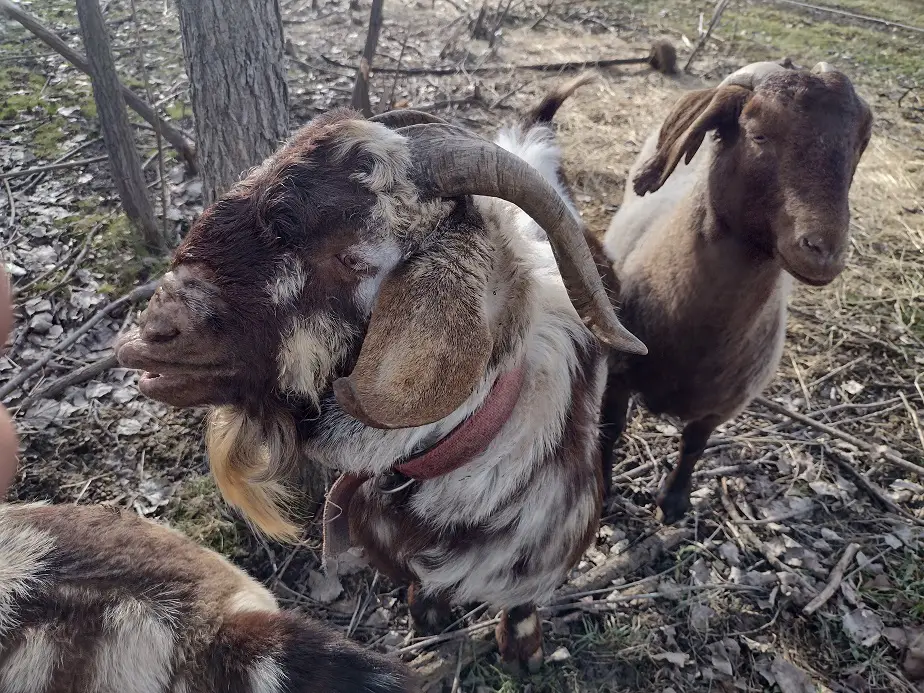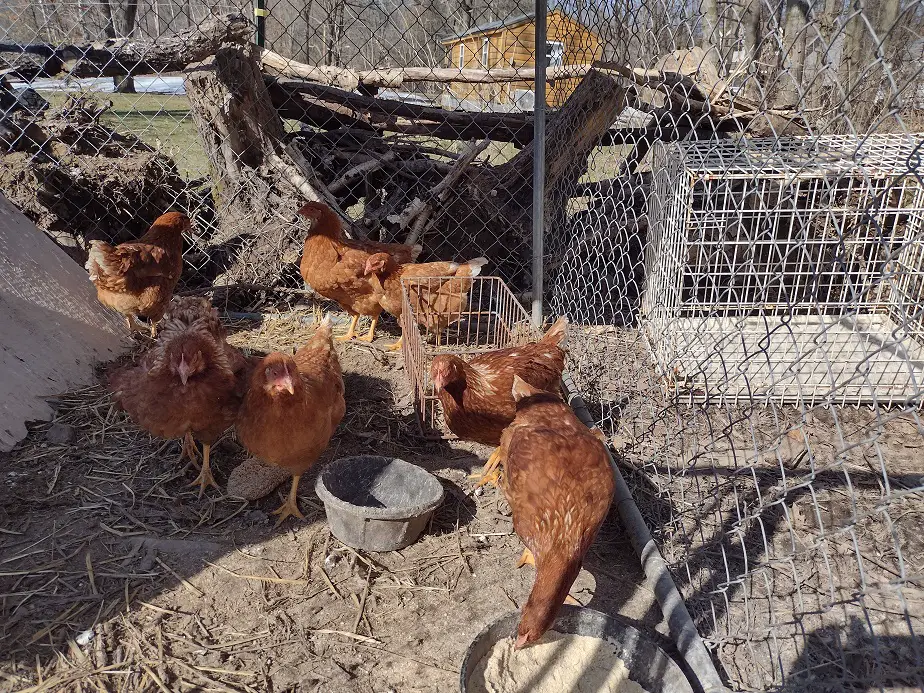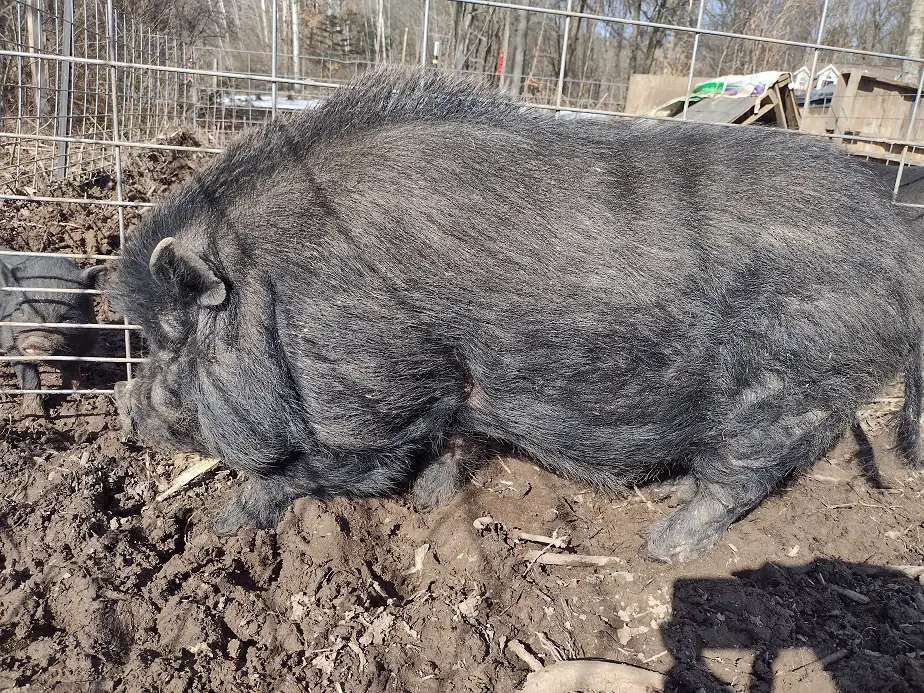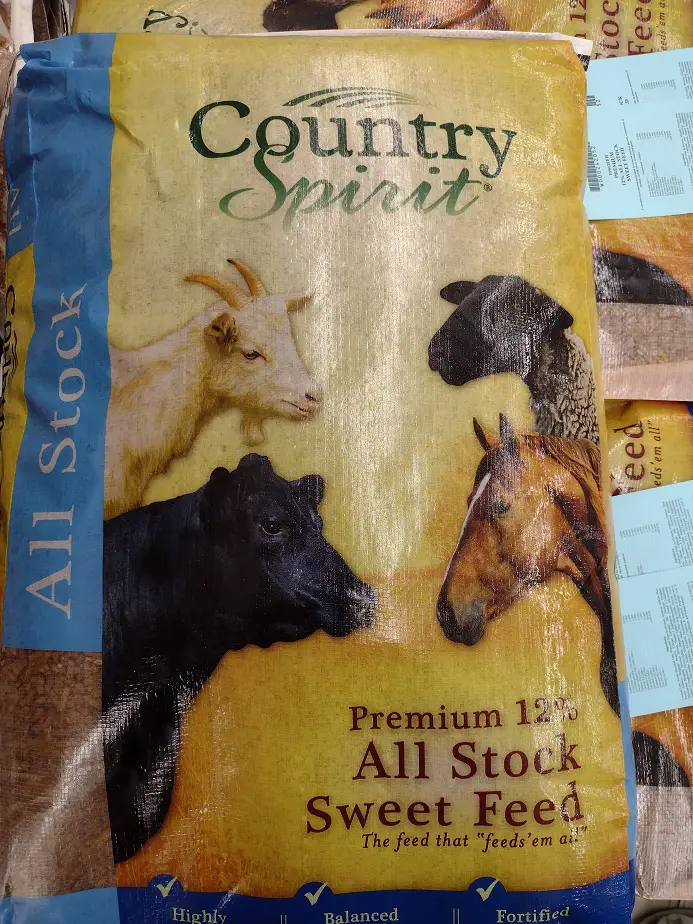All-stock can be pretty cheap and it’s more universal than you might expect.
Most animals can eat All-Stock but it’s usually intended for horses, sheep, goats, and cows. Poultry, pigs, and rabbits can be fed an all-stock feed, but it’s less ideal in many cases and should be limited or supplemented with other things. It’s generally high in fiber, low in protein, and a bit low in available energy.
I’ve reared a wide assortment of animals and everyone has had all-stock at some point. Do it right and it’s fine.
All-Stock feed is generally considered acceptable for:
- horses
- cows
- goats
- sheep
- lamas
- alpacas
- donkeys
- rabbits
In certain conditions, it’s acceptable for
- pigs
- chickens
Additional feeding supplements like hay or pasture are often recommended for grazing animals and kitchen scraps for chickens and pigs.

Feeding All-Stock to Grazing Animals.
Your average all-stock is a great feed for horses, cows, goats, and sheep. It’s about the feed equivalent of grassy hay with some grains and extra lysine; because that’s essentially what it is. Most all stock is or has mixed in, a pellet containing minerals, vitamins, grains, roughage, and protein.
Some blends also added grains like oats, wheat, and cracked corn just tossed in. Sometimes it has molasses added too. The extra grains bring up energy levels by adding extra carbs. Molasses does the same thing. Most that have molasses added will have only a little.
In my opinion, loose grains added to the feed also make it look nicer which helps convince people to buy a more expensive bag. Often, the cheapest stuff has the least amount of loose grains in the mix, although there’s usually plenty of ground grains in the pellet.
All-stock is a middle-of-the-road feed. It has enough nutrition for a non-working or not-much-working animal. If you are feeding it to a milking cow, you should offer her some fresh grass for vitamins, and maybe a good protein source like comfrey, alfalfa, or tree hay.
The same would go for a milking goat. You might also consider feeding something with a little extra energy, like some grains, fodder beet, or sugarbeet. If you were wanting to feed all-stock to a working animal, you better not work them a lot unless you give them some additional concentrated energy source.
All stock can be fed to sheep as is. Feed manufacturers take into account sheep’s sensitivity to copper, so that’s not an issue. All-stock is more energy-rich than the usual grass diet of sheep, but it’s much lower in vitamins and does not digest as well as a fresh green grass. A little fresh greens helps all animals.
Feed all stock to any animal that you would put out on pasture. Monitor their condition to see how they are maintaining health and body weight.
I’ll add rabbits to this group too. They have a similar diet to other pasture-grazing critters. Rabbits being raised for meat can be fed an all-stock. If you have a little higher protein fodder like alfalfa or most broad-leafed weeds, it will help.
Rabbits fed all-stock will probably end up a bit fatter, but that can be nice for a good roaster. The usual concern about giving rabbits another type of animal feed has to with too much calcium. Rabbits are sensitive to it.
All-stock isn’t usually too high in calcium, especially for a rabbit that will be butchered by 2-4 months old. If it were significantly cheaper than your other feed options, it may be worth a shot.

Feeding All-Stock to Chickens
Chickens can be fed all-stock and it’s a decent feed for roosters and old hens. It needs protein and calcium supplementation for laying hens and meat chickens. You can add crushed eggshells to the feed for calcium, and add protein from table scraps or a little soybean.
Laying hens need about a 16 percent protein feed to produce good eggs regularly. They also go through about 4 grams of protein daily between creating good eggshells and keeping their own bodies healthy. if they don’t get enough protein, they simply cannot create eggs regularly.
If a hen is lacking calcium, her body will begin repurposing some of the calcium from her bones to continue making eggshells, but in short order, her bones are weak and the eggshells are weak. I have had hens laying eggshells so thin and short of calcium that they cracked when being picked up.
Back when I was completely free-ranging my birds with no extra feed, I learned to dry and crush up the old eggshells finely and set the mash out in a bowl for the birds. It helped noticeably, but the eggshells still weren’t quite full strength.
Chickens need at least 3 grams of calcium a day for good shell strength. Eggshells are something like 40 percent calcium and chickens will eat the crushed shells, especially if they are lacking calcium.
Most all stock is lower in overall energy than chicken feed. Layer ration is about 80 percent corn, with soybean and added minerals. All stock usually has less grain, more fiber, and grain by-products like used brewer’s grain. It’s not bad, just often lower in starchy energy.
Here’s an article I wrote that goes deeper into this point.
If you are feeding all stock to laying chickens, you really up their health and egg-laying capacity quite a bit by adding the additional calcium and protein they need. Chickens need the sort of protein that comes from meat, bugs, or beans. Peas and sunflower seed are also great protein sources. We grow sunflower.

Feeding All-Stock to Pigs
All-stock can be used as a maintenance feed for mature pigs. It does not support the rapid growth of young pigs and it’s lacking as a feed for pregnant sows, but as a feed for older boars or sows that need to watch their weight, it’s a fine option. It’s acceptable for both mature farm hogs and mature pet pigs.
Consider all-stock like going on a high-vegetable diet. It’s lower in starch and protein, and higher in fiber. Most all stock has around 1 percent lysine and 12 percent overall protein, which is about where most mature pig maintenance feeds are at.
The common feed for an older sow, still being bred, is 13 percent protein and about 1 to 1-1/2 percent lysine. Pigs are sensitive to getting fat from excess protein. And, because bigger, mature pigs eat a lot, an old sow still gets plenty of protein overall for a litter of piglets.
But, most farmers give a higher protein feed after birthing to promote good milk production. I guess that makes sense. We have to take our best care of the young animals.
I fed our oldest sow an all-stock feed for the first 2 years that we had her. She got table scraps to help boost her diet during her first pregnancy. That pig was quite healthy and bore a good litter.
When we first got our boar, he was quite fat and fairly unhealthy. He went on a limited diet of all stock and grass for a few months, gained his vigor, and dropped 40 percent of his body weight (all extra fat). The local Michigan company that made the all-stock (Armada Feeds, I think) recommended it for that use.
They said it was acceptable for older hogs, outside pet pigs, and pigs that didn’t need a high-calorie, high-protein diet.
Some Breeds do better on a lower-concentration feed like that. Landrace pigs like the Kunekune and Potbelly Pig (almost the same thing) usually don’t need the production hog feed. Guinea Hogs are similar. Even if you are raising them for pork, they get little benefit from regular hog feed after 6 months of age.
Think about this. Pigs are weaned at 2 months old. During month 3, they can benefit from an 18 percent protein feed. During month 4, 16 percent protein is standard. Some folks drop down to a 15 percent protein feed for month 5. By month 6, it’s standard to be on a 14 percent feed until the butcher date.
Most pigs are butchered commercially by 6-7 months and small-time farmers go slightly longer to get a little more fat on them. Pigs’ needs for protein drop sharply by 6 months of age because that’s the end of their growth spurt. This is basically the same across all breeds.
Here’s a much deeper article on all-stock for pigs.
If you’re keeping a pig much longer than 8 months, I am totally fine with using an all-stock feed to at least see how it goes. at worst, you may need to give them a little extra corn or soybean, both of which can be fairly cheap from a legitimate feed store like a grain elevator or mill (not the hobby farm store).
Related Articles:

